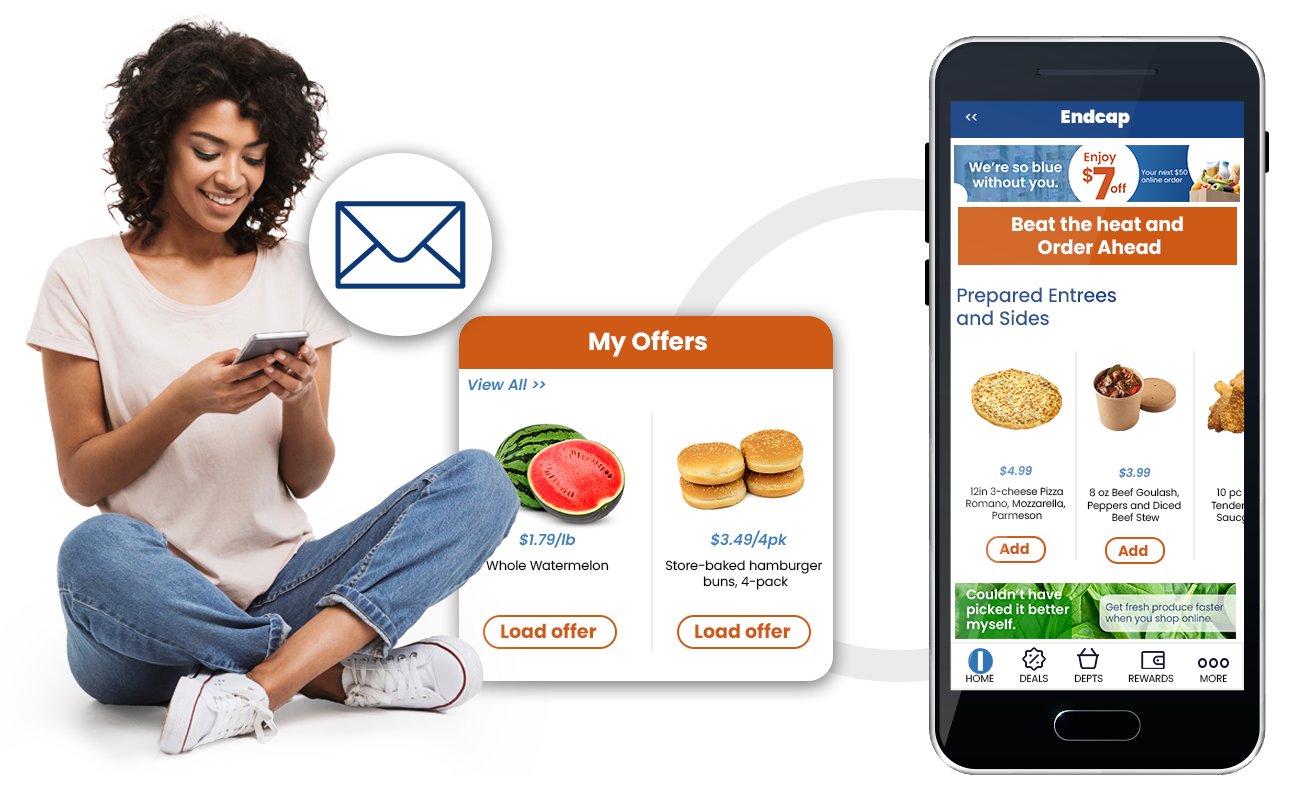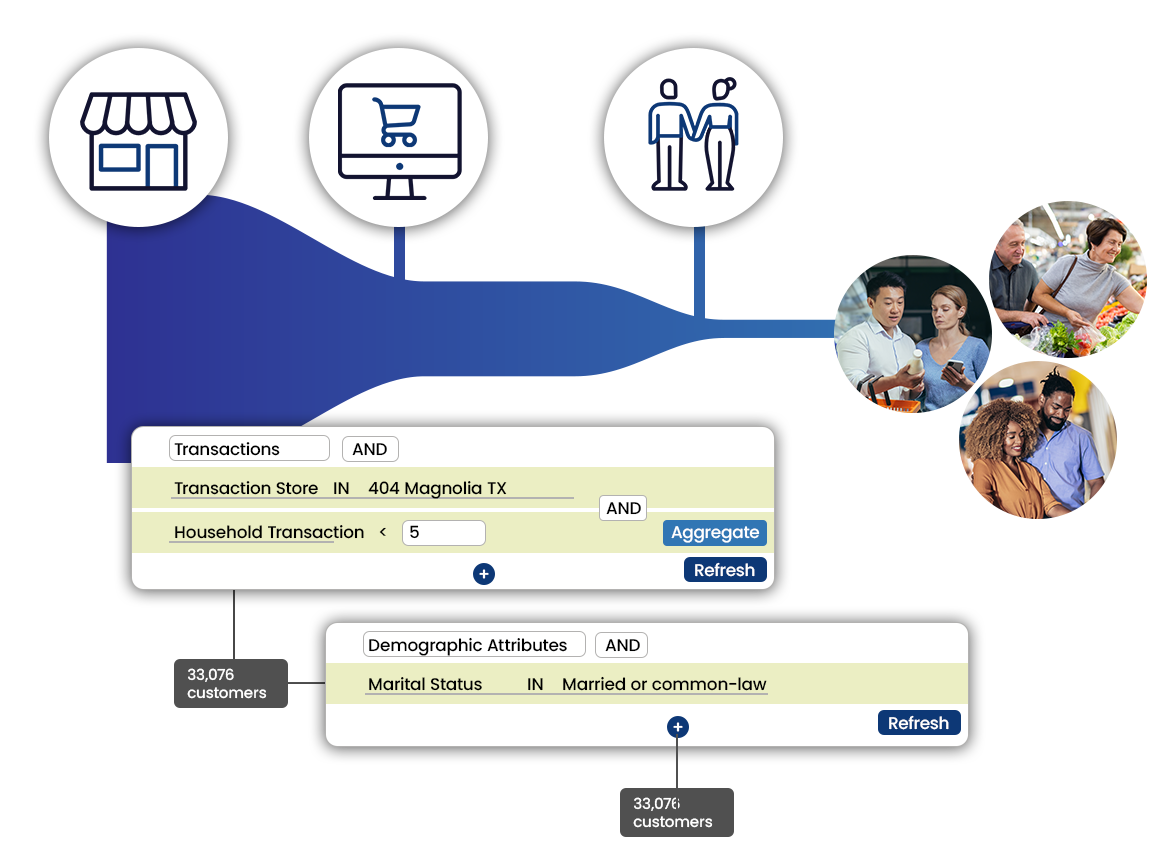Introduction
Grocery eCommerce platforms play a crucial role for grocery retailers. These platforms provide a simple and efficient way for customers to buy groceries without leaving their home. This convenience attracts more people to choose a retailer that makes online shopping easy for them.
These platforms aim to deliver value directly with content that pursues and communicates its products to its audience. Eye-catching UI and simplified UX allow easy access and use of these services.
Key features of successful grocery eCommerce platforms include reliable inventory management, secure payment processing, effective customer support, and mobile-friendly design. Each of these features contributes to a smooth and hassle-free shopping experience, making it possible for businesses to expand their reach and satisfy the needs of a diverse customer base.

Grocery eCommerce platforms not only facilitate online grocery shopping but also enhance the overall customer experience, adapting to the evolving preferences of today's consumers.
Inventory Management in Grocery eCommerce
Inventory management stands as a critical component of running a successful grocery eCommerce platform. It ensures that customers have access to available products in real time, enhancing their shopping experience, and it optimizes the inventory management of the store. Efficient inventory management involves two crucial aspects: keeping customers informed about stock levels and organizing products in a way that makes them easy to find.
Real-Time Stock Updates
Real-time stock updates are essential for maintaining customer satisfaction on a grocery eCommerce platform. This feature prevents the frustration that comes when customers select items, only to discover at checkout that they are no longer available. Immediate updates on availability help in managing customer expectations and reducing the chances of cart abandonment.
- Ensures customers see only available products, reducing disappointment.
- Helps manage expectations by showing exactly what is in stock.
- Prevents the sale of items that are out of stock, avoiding potential fulfillment issues.
Efficient Product Categorization
The way products are categorized on a platform significantly affects the shopping experience. Efficient product categorization helps customers navigate the site more easily, find what they need quickly, and possibly discover new products they want to try.
- Facilitates easier navigation, allowing customers to find items faster.
- Encourages product exploration, potentially increasing sales.
- Enhances the overall shopping experience by streamlining the search process.
Strategies for Managing Supply Levels
Maintaining the right level of inventory is crucial to avoid stockouts and overstocking, both of which can harm a business. Implementing effective strategies to manage supply levels ensures that a grocery eCommerce platform can meet customer demand without unnecessary surplus.
- Predictive Analytics utilize past sales data to forecast future demand, helping in ordering the right amount of stock.
- Automatic Reordering Systems trigger new orders based on preset stock levels, ensuring popular items are always available without leading to overstock.
- Regular Inventory Reviews conduct periodic checks to assess stock levels and adjust ordering patterns.
By focusing on these key areas, grocery eCommerce platforms can optimize inventory management practices, leading to both a better customer experience and more efficient operations.
Payment Processing Solutions
Secure and seamless transactions are the backbone of customer satisfaction in the grocery eCommerce platform. Offering various payment options caters to the diverse preferences of customers, making it easier for them to complete purchases. This flexibility in payment processing is not just a convenience but a necessity in digital shopping.
Secure, Seamless Transactions
The importance of providing secure, seamless transactions cannot be overstated. Customers need to trust that their financial information is safe every time they make a purchase. Ensuring smooth and secure transactions encourages customers to complete their purchases, reducing cart abandonment rates.
- Ensures customer financial information is protected, building trust.
- Reduces friction in the checkout process, making it easier for customers to buy.
- Supports a variety of payment methods, catering to different customer preferences.
Diverse Payment Options
Offering a range of payment options is also crucial for meeting customer expectations. People have their preferred ways to pay, and grocery eCommerce platforms that accommodate these preferences can significantly improve the shopping experience. This adaptability can lead to higher customer satisfaction and loyalty.
- Allows customers to use their preferred payment method, enhancing satisfaction.
- Increases the likelihood of completing a purchase, boosting conversion rates.
- Adapts to global customer bases by accepting different currencies and payment methods.
Impact on Customer Trust and Conversion Rates
How the grocery eCommerce platform handles payment processing can affect customer trust and conversion rates. Secure and efficient payment systems reassure customers, making them more likely to return for future purchases. Furthermore, a smooth checkout process that includes preferred payment options can directly influence the platform's conversion rates.
- Builds trust with secure transaction processes, encouraging repeat business.
- Enhances the checkout experience with diverse payment options, improving conversion rates.
- Demonstrates a commitment to customer convenience and security, strengthening the platform's reputation.
By prioritizing secure, seamless transactions and offering diverse payment options, grocery eCommerce platforms can enhance customer trust, improve the shopping experience, and ultimately drive higher conversion rates.
Delivery Options and Logistics
Grocery eCommerce platforms that offer a variety of delivery options stand out and cater to the diverse needs of customers. From same-day delivery to scheduled deliveries and pick-up points, these services enhance convenience and flexibility for the shopper. Efficient logistics management underpins these offerings, ensuring that groceries are delivered promptly and in optimal condition, directly affecting customer satisfaction and retention.
Differentiating Through Various Receiving Methods
The ability to offer multiple receiving options not only provides convenience but also empowers customers to choose a method that best suits their schedules and preferences. This flexibility is crucial in enhancing the customer shopping experience.
- Same-Day Delivery: Appeals to customers needing groceries urgently, offering unparalleled convenience.
- Scheduled Delivery: Allows customers to plan and receive their orders at a time that’s most convenient for them, enhancing the shopping experience.
- Pick-Up Points: Offers an alternative for customers who prefer to collect their groceries at a designated location, providing flexibility and possibly reducing delivery costs.
Logistics Management for Efficiency and Customer Satisfaction
The backbone of effective delivery options is a robust logistics management system. This system ensures that delivery operations are streamlined, from order processing to the final delivery, optimizing efficiency and minimizing delays or errors.
- Advanced Routing Algorithms: Utilize technology to determine the most efficient delivery routes, reducing delivery times and costs.
- Real-Time Tracking: Offers customers and businesses the ability to track orders in real-time, enhancing transparency and trust.
- Inventory and Order Management Integration: Ensures delivery operations are closely integrated with inventory management, reducing errors and improving efficiency.
By focusing on diverse delivery options and efficient logistics management, grocery eCommerce platforms can significantly enhance customer satisfaction. This not only meets the immediate needs of customers but also builds long-term loyalty by consistently providing a reliable, flexible, and satisfactory shopping experience.
Integration with Existing Systems
For grocery eCommerce platforms, seamless integration with existing systems such as Point of Sale (POS), Customer Relationship Management (CRM), and Enterprise Resource Planning (ERP) systems is crucial. This integration streamlines operations across various aspects of the business, from inventory management to customer engagement and backend logistics. By ensuring these systems work together harmoniously, grocery eCommerce platforms can enhance operational efficiency and provide a smoother shopping experience for customers.
Seamless Integration for Streamlined Operations
Integrating eCommerce platforms with POS, CRM, and ERP systems allows for real-time data exchange and automation of processes. This connectivity ensures that all parts of the business are informed and responsive to each other's needs.
- POS Integration: Ensures sales data is immediately captured and reflected across the platform, aiding in accurate inventory management.
- CRM Integration: Offers a comprehensive view of customer interactions and preferences, enabling personalized marketing and support.
- ERP Integration: Streamlines back-end operations such as order processing, inventory management, and logistics, ensuring they operate efficiently and cohesively.
Benefits of Integration
The integration of grocery eCommerce platforms with existing business systems brings about several key benefits that can significantly impact inventory management, customer data analysis, and overall operational efficiency.
- Enhanced Inventory Management: Real-time synchronization between the eCommerce platform and inventory systems helps in maintaining accurate stock levels, reducing the risk of overstocking or stockouts.
- Improved Customer Data Analysis: By combining eCommerce data with CRM insights, businesses can gain a deeper understanding of customer behavior and preferences, leading to more effective marketing strategies.
- Increased Overall Efficiency: Integration automates many manual processes, reducing errors and saving time. This efficiency can lead to cost savings and allows staff to focus on more strategic tasks.
Through seamless integration with POS, CRM, and ERP systems, grocery eCommerce platforms can optimize their operations and offer an enhanced shopping experience. This not only improves internal efficiencies but also boosts customer satisfaction and loyalty by ensuring that customers have a seamless and personalized shopping journey.
Security and Compliance Measures
Ensuring the security of customer data and transactions is fundamental to the operation of all grocery eCommerce platforms. Adhering to data protection laws and payment security standards is not just about compliance; it's a fundamental aspect of building trust and maintaining the integrity of the online shopping experience. Implementing best practices for security can protect customers and the platform from potential threats.

Adherence to Data Protection Laws and Payment Security Standards
Staying compliant with data protection laws and following payment security standards like PCI DSS is critical for any grocery eCommerce platform. These regulations are designed to safeguard customer information and ensure secure financial transactions.
- Data Protection Laws: Compliance with local laws often involves obtaining consent for data collection, ensuring transparency about data use, and providing security measures to protect personal information.
- Payment Security Standards: Following PCI DSS guidelines helps protect payment information during and after transactions, requiring encryption, secure networks, and regular security assessments.
Implementing Best Practices to Safeguard Customer Information and Transactions
Implementing security best practices is essential for protecting customer information and ensuring safe transactions. These measures not only prevent data breaches and financial fraud but also reinforce customer confidence in the platform.
- Regular Security Audits: Conducting regular security assessments can identify vulnerabilities and help in fortifying the platform against attacks.
- Encryption Technologies: Using encryption for data storage and transmission protects sensitive information from unauthorized access.
- Multi-Factor Authentication (MFA): Implementing MFA for customer accounts adds an extra layer of security, making it harder for unauthorized users to gain access.
- Continuous Monitoring and Response: Establishing a system for continuous monitoring of security threats and having a response plan in place ensures that any potential breaches can be quickly addressed.
Grocery eCommerce platforms should always offer a safe environment for customers to shop. A commitment to security not only protects the platform and its customers from cyber threats but also enhances the overall reputation of the grocer, fostering trust and long-term loyalty among its customers.
Addressing Inventory and Supply Chain Challenges
For grocery eCommerce platforms, managing inventory and navigating supply chain disruptions is critical for maintaining product availability and customer satisfaction. Effective tactics and flexible strategies are essential to ensuring that customers always find what they're looking for and that their orders are fulfilled promptly and accurately.
Tactics for Managing Supply Chain Disruptions
Supply chain disruptions can significantly impact inventory levels and lead to shortages or delays. Employing proactive tactics can help mitigate these challenges, keeping operations smooth and customers happy.
- Diversified Supplier Networks: Building relationships with multiple suppliers ensures that if one faces issues, others can fill the gap, maintaining the supply chain's integrity.
- Advanced Forecasting Tools: Utilizing technology to predict demand more accurately can help in planning inventory needs, reducing the impact of sudden market changes.
- Flexible Inventory Management: Implementing systems that can quickly adapt to changes, such as adjusting order quantities or rerouting supplies, helps manage unexpected disruptions efficiently.
Importance of Reacting to Supply Chain Issues
Adapting to supply chain challenges is crucial for the resilience and reliability of grocery eCommerce platforms. This flexibility ensures that platforms can quickly adapt to changes or challenges in the supply chain, minimizing impacts on product availability and customer experience.
- Adaptability to Market Changes: Being able to swiftly adjust supply chain operations in response to market trends or disruptions is key to maintaining steady inventory levels and meeting customer demand.
- Responsive Replenishment Systems: Systems that automatically adjust order quantities based on real-time sales data can help prevent overstocking and stockouts, ensuring optimal inventory levels.
- Collaboration with Logistics Partners: Working closely with logistics and delivery partners ensures that the supply chain is efficient and capable of adapting to changes, such as increased demand or delivery challenges.
Grocery eCommerce platforms can use these tactics and supply chain strategies to simplify inventory management and relieve supply chain disruptions. Thus, these platforms ensure product availability and timely delivery and enhance customer trust and loyalty by demonstrating reliability even in the face of challenges.
Conclusion
The right grocery eCommerce platform not only facilitates transactions but also creates a seamless, secure, and enjoyable shopping experience that meets the changing needs of customers. By prioritizing customer experience, embracing innovation, and committing to continuous improvement, businesses can not only meet but exceed customer expectations, securing their loyalty and driving long-term growth.
Frequently Asked Questions
How does user-friendliness impact the success of a grocery eCommerce platform?
User-friendliness is fundamental to the success of a grocery eCommerce platform. A platform that is easy to navigate and intuitive allows customers to find and purchase their groceries with minimal hassle, significantly enhancing the shopping experience. Features such as clear categorization, responsive design, and easy checkout processes contribute to a platform's user-friendliness. Platforms that prioritize these aspects tend to see higher customer satisfaction rates, increased repeat business, and improved overall sales.
Can grocery eCommerce platforms integrate with existing POS systems?
Grocery eCommerce platforms can integrate with existing Point of Sale (POS) systems. This integration is crucial for maintaining real-time synchronization between online and in-store sales, inventory management, and customer data. It ensures that stock levels are updated instantly across all channels, preventing overselling and stockouts. Additionally, POS integration can offer insights into shopping behaviors, enabling personalized marketing and promotions, thereby enhancing the customer experience both online and in-store.
What are the best security practices for grocery eCommerce platforms?
Securing customer data and transactions is vital for grocery eCommerce platforms. Adhering to best security practices involves several key strategies:
- Compliance with Data Protection Laws: Ensuring all customer data is handled in compliance with local legal requirements.
- Following Payment Security Standards: Adopting standards such as PCI DSS to safeguard payment information.
- Implementing Encryption: Using encryption for all data transmission and storage to protect against unauthorized access.
- Regular Security Assessments: Conducting periodic audits to identify and rectify potential vulnerabilities.
- Multi-Factor Authentication (MFA): Requiring MFA for customer accounts to add an extra layer of security.



